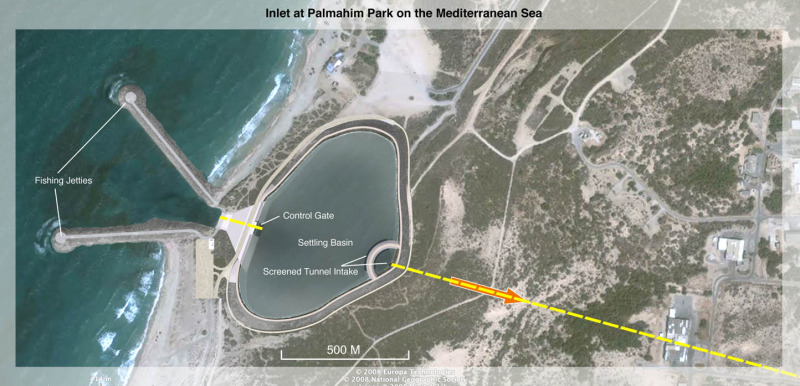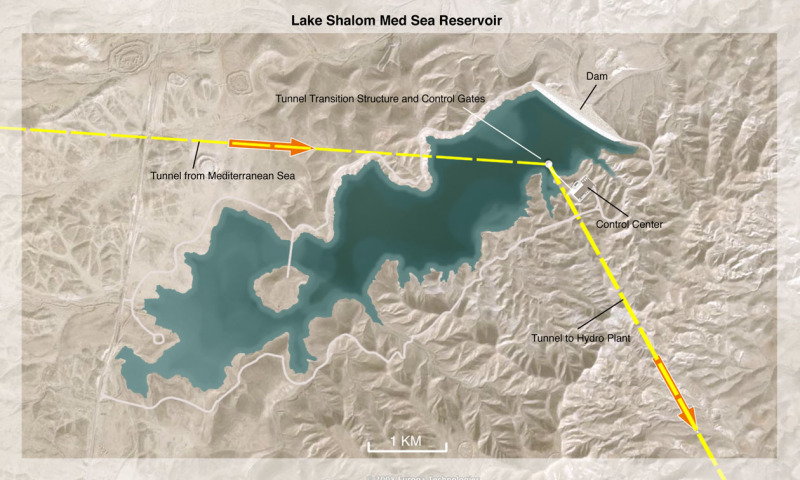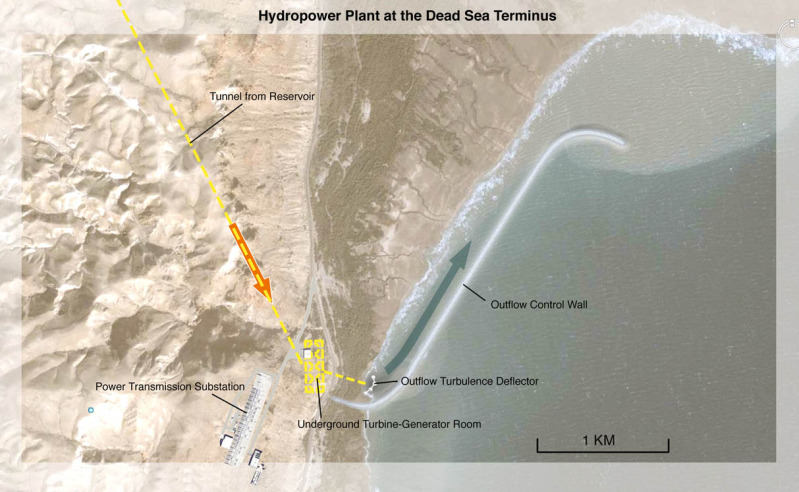Med Dead Vision Overview
RG/MB Sept 11, 2009
"Green Power", Desalinated Water, Saving the Dead Sea: The Med Dead Vision, which incorporates the Dead Sea Power Project plan, www.deadseapower.com, will be designed to provide 1500 to 2500 MW of green energy, plus an abundant supply of desalinated water for the region, while saving the Dead Sea.
Sea Inlet: The Sea Inlet at Palmahim Park will be environmentally friendly, and provide additional facilities for recreational fishing. Excavation of an inlet basin in the Calcareous Sandstone will leave the sand beach area undisturbed, control muddy water from the tunnel boring, and provide material for the building of stone jetty walls serving the dual purpose of protecting the inlet structures, and providing rock pier fishing area.

Inlet Channel and Basin at Palmahim
Tunnel Construction: The 72 kilometer length, 10 meter diameter tunnel from Palmahim to the transition structure in the reservoir lake on the south branch of Wadi Qumeran will be constructed below sea level, to provide for energy efficiency by natural flow, without pumping. It will be lined with pre-cast segmented reinforced concrete tunnel lining to prevent any inflow of water from the overlying coastal and mountain aquifers. There is zero risk of contamination of aquifers, as there will be external pressure on the tunnel lining under the aquifers. Any leak in the tunnel lining would allow the inflow of water into the tunnel, with no risk of outflow of marine water to the overlying aquifers. A fail-safe water gate with redundant and manual override controls will control flow into the tunnel. Another gate will control flow from the inlet channel into the inlet basin.

Tunnel Route
Flow Control: The flow of seawater from the tunnel will be controlled by a transition structure housing three water gates, one from the tunnel, one from the reservoir, and one for the penstock to the hydro power plant. It is planned that 5 billion cubic meters of water would flow to the Dead Sea annually through this structure, generating 4.57 billion kWh annually green, renewable energy, and filling the Dead Sea to the desired level within seven years of operation.
Lake Shalom: The storage reservoir for the tunnel flow will be located in a natural basin on the south branch of Wadi Qumeran, by construction of an earthquake resistant dam utilizing spoil from the tunnel boring. The lake will have a surface area of about 3 square kilometers, and maximum depth at the dam of 80 meters. Flow from the tunnel will be stored in this reservoir, with the surface elevation changing daily about three meters. This will produce a tidal effect for the shoreline, and encourage normal marine ecology. This variation in water level is necessary to provide for maximum generation of energy during the peak demand cycle of the electric grid. This energy for peaking is valued at about three times the base load tariff.

Lake Shalom, Tunnel Flow Storage Reservior
This beautiful marine lake, twenty miles from Jerusalem, will be a magnet for tourism and residential development. Surely the name, Peace Lake, is suitable for this setting and for the benefits it will bring the region.
From Reservoir to the Dead Sea: The penstock from the reservoir to the Dead Sea will be designed to provide for 800 cm/sec flow, enough to power 2500 megawatt hydro turbine generator capacity. The power plant can be designed to start at 1500 megawatts, and expand when the market justifies. Surge chambers will be constructed in the penstock near the hydropower plant, to prevent water hammering from sudden closure of a water gate, which caused the August 2009 incident in Russia; Russia’s plant was operating at about 200 meters head, about half the pressure for our plant.
Hydro Plant: The hydroelectric plant will require earthquake resistant construction, and has been located in very stable geological formation where the Dead Sea has a very steep shoreline, to avoid construction in alluvial fill, which is subject to soil liquefaction during an earthquake. The steep shoreline limits the length of the draft tubes exiting the turbines, and increases the efficiency of the plant. The turbine room will be constructed below ground, below the present level of the Dead Sea, inside the stable geological formation at the site selected.
Filling the Dead Sea: Flow into the Dead Sea will be controlled by an outflow wall separating the turbine outflow from the Dead Sea. Water will move northward behind the wall to a shallow area where the water can be released without mixing with the deeper Dead Sea water. Exiting water will spread out in the shallow area, producing non-turbulent flow that will layer on top of the much denser Dead Sea water. This layer of Med Sea water on top of the Dead Sea will be maintained by constant removal and replacement of the top two meters for desalination feed water. This will require development of up to 2 billion cm desalination capacity near Potash City and En Gedi, by Jordan and by Israel, to supply water for the proposed Peace Valley development. Jordan will have access anywhere on their side of the Dead Sea for Med Sea water for desalination. They have already announced future plans for location of Nuclear plants to supply energy for desalination on the Dead Sea, connected with their vision of the Red-Dead project. Our project will enable saving the Dead Sea and supplying them feed water for desalination.

Hydropower Plant Underground in Solid Halite Formation
Saving the Dead Sea Environment: The Dead Sea "experience" can be preserved in areas designated as Dead Sea Preservation Parks by construction of dykes above present Dead Sea level at the time of construction of the project. Large diameter pipes extending through the dykes and down several meters into the existing Dead Sea water will cause the pure Dead Sea water to be pushed up behind the dykes as the Dead Sea fills with water from the Med Sea.

En Gedi would be one location where this preservation project should be developed, keeping the Dead Sea experience alive, with people experiencing the buoyancy of the real Dead Sea water. Meanwhile, on the other side of the dyke, tourists can enjoy recreational boating and fishing in the Med Sea water covering the major part of the Dead Sea.
Certainly this will be a unique place that will draw people from all over the world, bringing prosperity to the region. The Dead Sea will become the live sea, with all the fish of the Med Sea living there, and millions of tourists from all over the world visiting this marvelous place where breathing is easier, healing is in the mud, sea life abounds and where you can read your newspaper while floating on your back.
Benefits:- Promote peace by supplying opportunities for development of the West Bank.
- Supply critically short water and green power for the region.
- Reinvigorate the regional ecosystem by saving the Dead Sea and enabling tourism development in the area.
- Supply low cost water for settlements of the Northern Negev
- Create a large marine lake on the south branch of Wadi Qumeran, enabling economic development and supply of desalinated water for Jerusalem and the West Bank. This beautiful lake in pristine Judean Hills setting will be a magnet for tourism developments.
- Provide a massive boost to employment opportunities.
Cost of project estimated to be $5790 million.
Peace Valley: This proposal is offered as an aid to accomplish the goals of the Peace Valley Economic Corridor proposed by President Shimon Peres and approved by the governments of Israel and Jordan. This project can facilitate the objectives of the Red-Dead Project to save the Dead Sea and supply abundant water for the region.